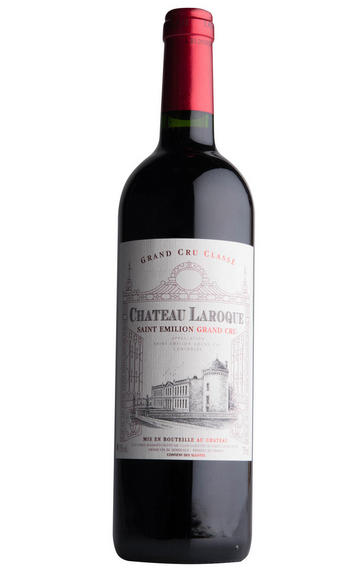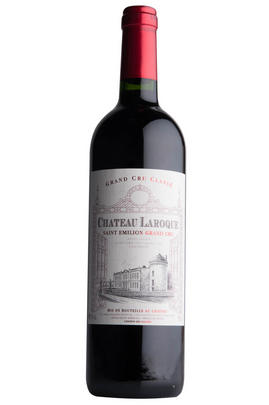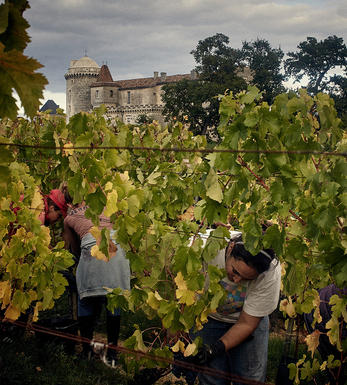
2021 Château Laroque, St Emilion, Bordeaux

Critics reviews
The 2021 Laroque has upped its game in recent vintages under David Suire. It was cropped between 1 and 15 October at 41hL/ha, and matured in 50% new oak. It has a refined bouquet with brambly red fruit, light undergrowth and mineral scents. The palate is medium-bodied with fine-grain tannins, poised and again, mineral-driven thanks to its limestone soils. This latest release continues that fine run of form but will be more approachable than recent vintages.
Drink 2027 - 2040
Neal Martin, vinous.com, (May 2022)
The 2021 Laroque is a standout. Bright and racy, with tremendous persistence, Laroque stakes its claim as Saint-Émilion's brightest rising star. Bright limestone accents run through a core of red/purplish fruit, rose petal, mint and white pepper. There is a linear intensity to Laroque that is hugely appealing. Technical Director David Suire fashioned a gem. Don't miss it.
Drink 2028 – 2046
Antonio Galloni, Vinous (May 2022)
This is juicy, mouthwatering, has a pumice-stone limestone texture and a slow unrolling of plum and raspberry fruits and smoked spices while maintaining grip. They have been making great wine here over recent vintages, and to keep the quality in 2021 is worthy of congratulations. One to look out for. Beaurmartin family, David Suire director, 61ha size, 41hl/h yield. 45% of production in the Grand Vin.
Drink 2026 - 2040
Jane Anson, janeanson.com (May 2022)
Deep crimson hue. Dark and racy on the nose. Good depth of succulent mid-palate fruit. Plenty of polished tannin providing drive and persistence. A little chalkiness but nothing abrasive. Ambitious and with potential.
Drink 2027 - 2038
James Lawther, jancisrobinson.com (May 2022)
The 2021 Laroque is very promising indeed, and winemaker David Suire and I agree that it is likely to surpass the estate's 2018 vintage in quality. Unwinding in the glass with aromas of sweet berries, plums and cherries, framed by a discreet patina of new oak, it's medium to full-bodied, seamless and complete, with excellent concentration, lively acids and ripe, melting tannins. A blend of 99% Merlot and 1% Cabernet Franc, it represents 45% of the estate's production and derives from vines more than 50 years old.
William Kelley, Wine Advocate (Apr 2022)
About this WINE

Château Laroque
Château Laroque is a large St. Emilion estate famous for its stunning 18th century château as well as for the quality of its wines. It is owned by the Beaumartin family and was granted Grand Cru Classé status in 1996.
Its 61 hectares of vineyards (27 of which are used for the Grand Vin) are situated in the commune of St. Christophe des Bardes and it produces nearly 25,000 cases a year. The blend is predominately Merlot based and the wine is aged in oak barrels for 12 months. In the best years it is packed with ripe and plummy fruit supported by a framework of supple tannins and balanced acidity.

St Émilion
St Émilion is one of Bordeaux's largest producing appellations, producing more wine than Listrac, Moulis, St Estèphe, Pauillac, St Julien and Margaux put together. St Emilion has been producing wine for longer than the Médoc but its lack of accessibility to Bordeaux's port and market-restricted exports to mainland Europe meant the region initially did not enjoy the commercial success that funded the great châteaux of the Left Bank.
St Émilion itself is the prettiest of Bordeaux's wine towns, perched on top of the steep limestone slopes upon which many of the region's finest vineyards are situated. However, more than half of the appellation's vineyards lie on the plain between the town and the Dordogne River on sandy, alluvial soils with a sprinkling of gravel.
Further diversity is added by a small, complex gravel bed to the north-east of the region on the border with Pomerol. Atypically for St Émilion, this allows Cabernet Franc and, to a lesser extent, Cabernet Sauvignon to prosper and defines the personality of the great wines such as Ch. Cheval Blanc.
In the early 1990s there was an explosion of experimentation and evolution, leading to the rise of the garagistes, producers of deeply-concentrated wines made in very small quantities and offered at high prices. The appellation is also surrounded by four satellite appellations, Montagne, Lussac, Puisseguin and St. Georges, which enjoy a family similarity but not the complexity of the best wines.
St Émilion was first officially classified in 1954, and is the most meritocratic classification system in Bordeaux, as it is regularly amended. The most recent revision of the classification was in 2012

Merlot
The most widely planted grape in Bordeaux and a grape that has been on a relentless expansion drive throughout the world in the last decade. Merlot is adaptable to most soils and is relatively simple to cultivate. It is a vigorous naturally high yielding grape that requires savage pruning - over-cropped Merlot-based wines are dilute and bland. It is also vital to pick at optimum ripeness as Merlot can quickly lose its varietal characteristics if harvested overripe.
In St.Emilion and Pomerol it withstands the moist clay rich soils far better than Cabernet grapes, and at it best produces opulently rich, plummy clarets with succulent fruitcake-like nuances. Le Pin, Pétrus and Clinet are examples of hedonistically rich Merlot wines at their very best. It also plays a key supporting role in filling out the middle palate of the Cabernet-dominated wines of the Médoc and Graves.
Merlot is now grown in virtually all wine growing countries and is particularly successful in California, Chile and Northern Italy.


Buying options
Add to wishlist
Description
Merlot 99%, Cabernet Franc 1%
Laroque’s star continues to rise under David Suire’s direction. This excellent 2021 easily matches the successes of other recent vintages. The estate is blessed with two different limestone terroirs, which are vinified separately initially. It is these that give the wine its grip, and intensity, all with a whiff of coal dust. The harvest was finished quite late, which has given heft and richness to the wine. Its softer, dark-berry Merlot fruit is sumptuous. Closed now, this is very likely to be even better after bottling. Drink 2027-2042.
Our score: 16/20
Berry Bros. & Rudd, April 2022
wine at a glance
Delivery and quality guarantee